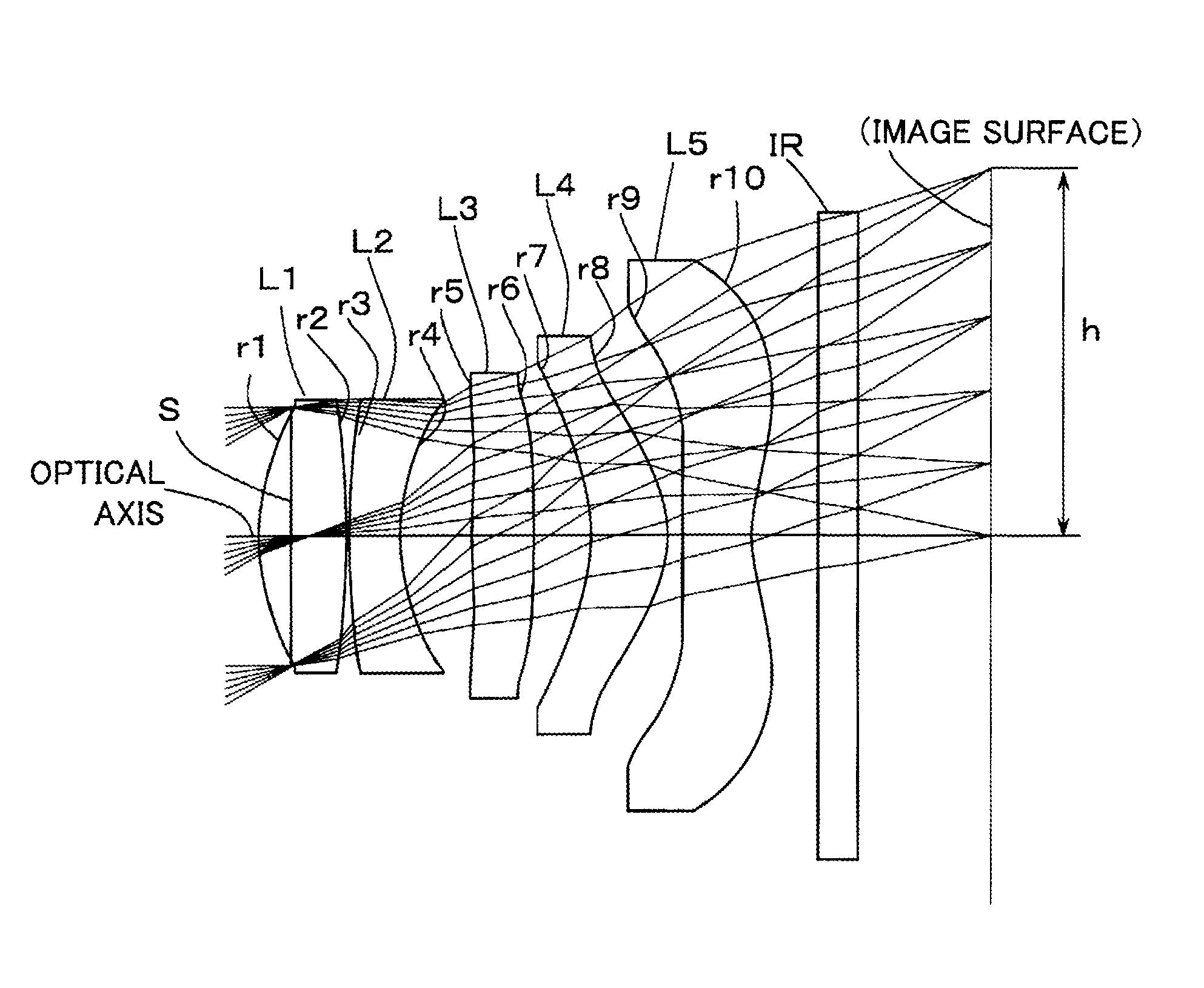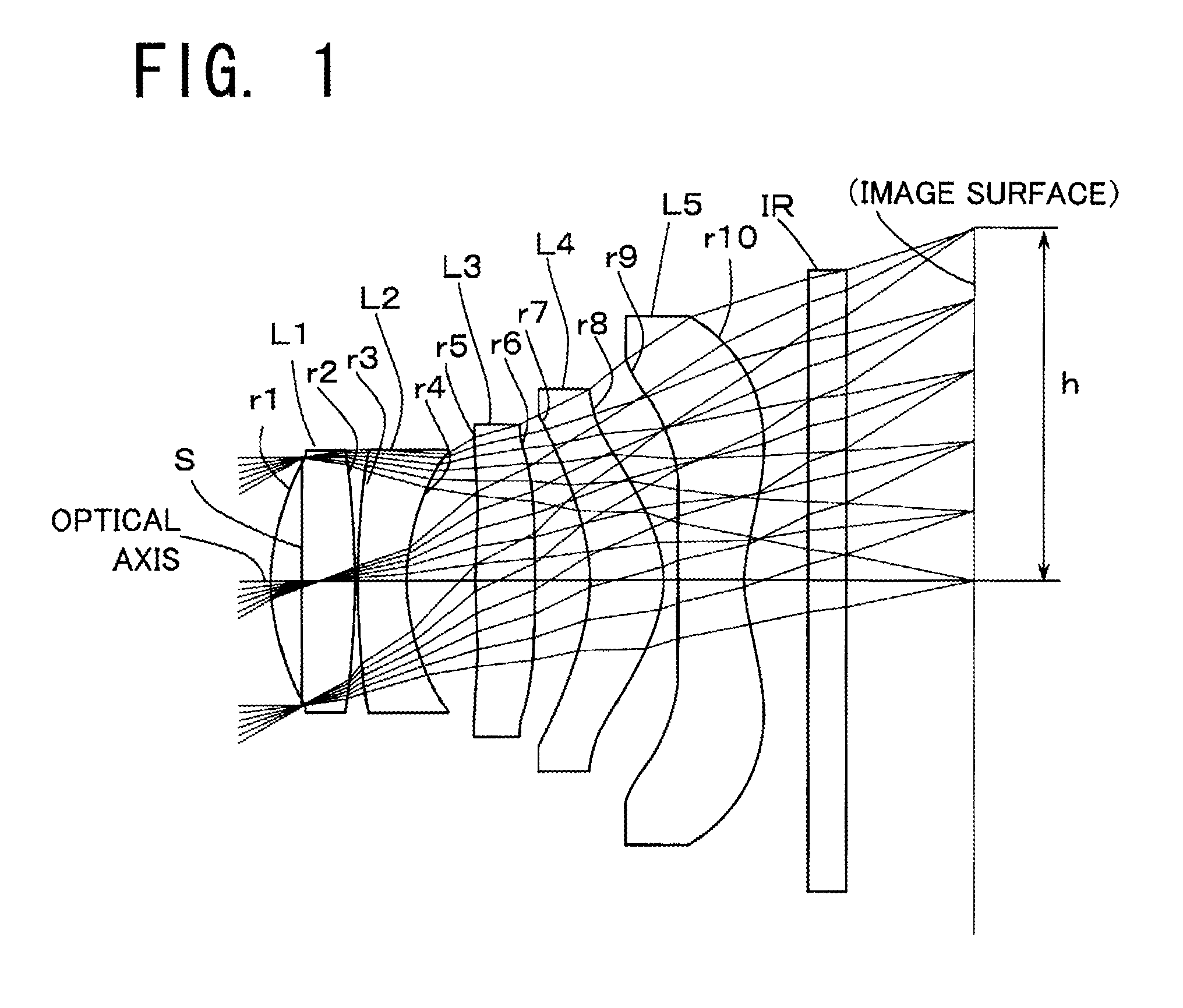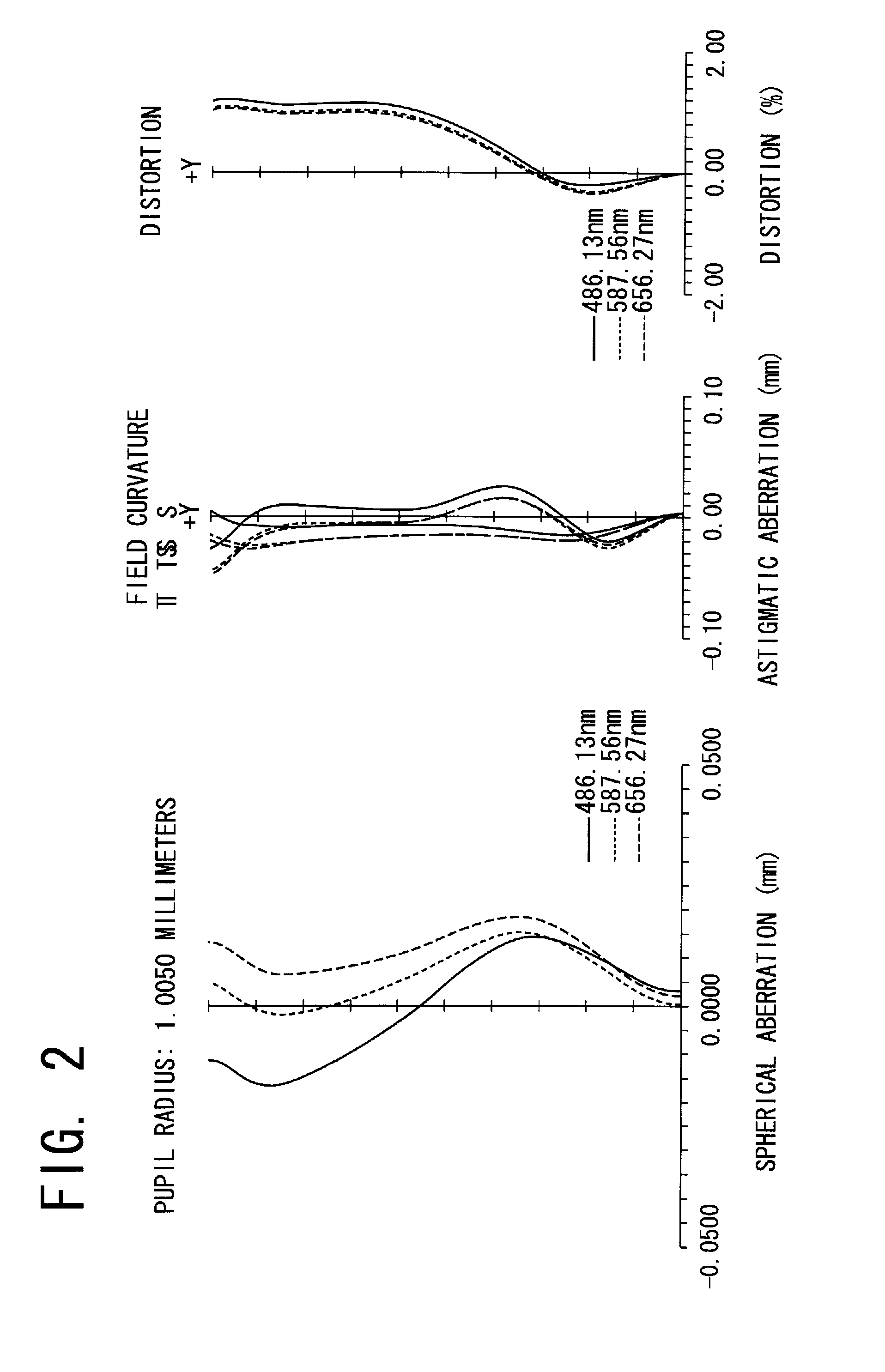Imaging lens
a technology of spherical aberration and lens, applied in the field of imaging lenses, can solve the problems of difficult to reduce costs, difficult to realize both the miniaturization and the aberration correction, and achieve the effects of small and high-performance, favorable correction of spherical aberration, and weak
- Summary
- Abstract
- Description
- Claims
- Application Information
AI Technical Summary
Benefits of technology
Problems solved by technology
Method used
Image
Examples
example 1
[0052]Basic data about the imaging lens according to Example 1 is shown in Table 1.
[0053]
TABLE 1f = 4.831 Fno = 2.404 ω = 30.52°iRdNdνdS (aperture stop)∞−0.2451*1.9220.67191.534656.22*−5.1670.0233*7.0380.3871.614225.64*1.6200.5565*8.5030.4691.534656.26*−50.0000.43957*−1.7210.591.534656.28*−0.9730.129*11.9400.53281.534656.210* 1.3870.511 ∞0.31.516864.212 ∞1.004IMA∞ikA4A6A8A10A12A141*−9.000E−01 1.430E−02−1.080E−02 5.887E−03−2.142E−03 −1.326E−03−3.454E−03 2*−1.047E+02 9.432E−031.860E−02−3.020E−02−1.020E−02 7.164E−03−1.107E−03 3* 1.480E+01−2.200E−026.650E−02−5.380E−021.540E−03−8.125E−055.368E−034*−5.590E−01−1.289E−011.729E−01−1.069E−013.120E−02−3.246E−033.809E−035*−3.000E+02−4.320E−02−2.420E−02 1.130E−026.194E−03 3.310E−03−6.472E−04 6* 0.000E+00−8.460E−025.240E−02−4.560E−021.720E−02−6.281E−046.879E−047* 4.100E−01 3.590E−028.680E−02−5.010E−021.410E−02−4.669E−040.000E+008*−2.797E+00−1.370E−02−5.428E−03 2.020E−02−3.985E−03 −6.448E−041.466E−049* 1.4901E+01−7.790E−0...
example 2
[0058]Basic data about the imaging lens according to Example 2 is shown in Table 2.
[0059]
TABLE 2f = 4.30 Fno = 2.80 ω = 33.72°iRdNdνdS (aperture stop)∞−0.141*1.9140.81.534656.22*−4.5500.03163*13.5320.3411.614225.64*2.0040.4875*50.0000.4611.534656.26*−15.2740.2317*−2.3090.661.534656.28*−1.1550.039*70.0001.061.534656.210* 1.5310.3811 ∞0.31.516864.212 ∞0.622IMA∞ikA4A6A8A10A12A141*−1.050E+00 2.815E−031.440E−02−3.030E−020.000E+000.000E+000.000E+002*0.000E+00 4.410E−02−7.010E−02 3.583E−030.000E+000.000E+000.000E+003*−4.100E+01 −2.050E−025.170E−02−7.660E−023.520E−020.000E+000.000E+004*0.000E+00−9.620E−021.891E−01−1.906E−011.289E−01−3.430E−02 0.000E+005*1.470E+02−9.320E−02−2.630E−02 4.700E−02−1.860E−02 1.190E−020.000E+006*0.000E+00−7.150E−021.610E−02−3.810B−021.320E−025.080E−030.000E+007*1.380E+00 6.860E−021.840E−02−3.500E−029.312E−032.952E−030.000E+008*−2.700E+00 −3.830E−021.520E−02 1.210E−02−7.534E−03 1.282E−030.000E+009*0.000E+00−9.020E−021.266E−02 3.429E−03−9.405E−04 ...
example 3
[0063]Basic data about the imaging lens according to Example 3 is shown in Table 3.
[0064]
TABLE 3f = 3.409 Fno = 2.550 ω = 39.996°iRdNdνdS (aperture stop)∞−0.121*1.5860.5181.534656.22*−6.1030.0383*8.8510.281.614225.64*1.7590.33145*8.3480.39451.534656.26*66.0000.3367*−2.0680.43671.534656.28*−0.9080.2559*23.6730.531.534656.210* 1.0890.3811 ∞0.31.516864.212 ∞0.391IMA∞ikA4A6A8A10A12A141*−1.000E+00 5.821E−032.220E−02−1.435E−010.000E+000.000E+000.000E+002* 0.000E+00 7.423E−03−1.152E−01 −2.403E−030.000E+000.000E+000.000E+003*−1.680E+02−3.130E−023.670E−02−5.950E−021.349E−010.000E+000.000E+004* 0.000E+00−9.610E−021.910E−01−1.769E−011.600E−01−3.130E−02 0.000E+005*−9.400E+01−9.200E−026.268E−03 4.880E−02−3.860E−02 2.407E−040.000E+006* 0.000E+00−8.910E−023.784E−03−2.820E−021.800E−026.949E−030.000E+007* 1.170E+00 7.550E−026.515E−03−3.460E−021.210E−024.966E−030.000E+008*−2.865E+00−2.270E−022.790E−02 1.540E−02−8.151E−03 6.265E−040.000E+009* 0.000E+00−9.070E−028.390E−03 3.833E−03−5.748...
PUM
 Login to View More
Login to View More Abstract
Description
Claims
Application Information
 Login to View More
Login to View More - R&D
- Intellectual Property
- Life Sciences
- Materials
- Tech Scout
- Unparalleled Data Quality
- Higher Quality Content
- 60% Fewer Hallucinations
Browse by: Latest US Patents, China's latest patents, Technical Efficacy Thesaurus, Application Domain, Technology Topic, Popular Technical Reports.
© 2025 PatSnap. All rights reserved.Legal|Privacy policy|Modern Slavery Act Transparency Statement|Sitemap|About US| Contact US: help@patsnap.com



